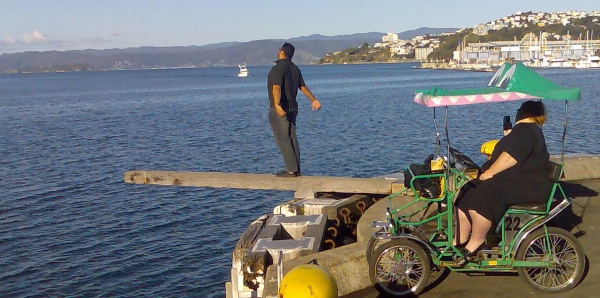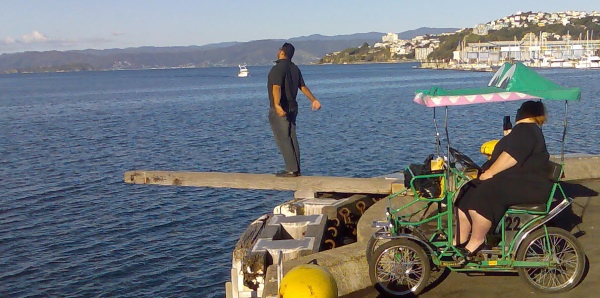The Wellington City Council must have known it was going to be picking a hard road to go down when it proposed Variation 11, and sure enough, the District Plan change is due to go to appeal at the Environment Court. Most of our readers will know about it: it’s a variation to permit buildings of a certain size to be constructed on the waterfront, without having to go through the publicly-notified Resource Consent stage. At present, of course, there’s a much more public-friendly situation in place: that every building higher than ground level will require to be notified – which means that you, the public, gets to have a potential say in everything that happens.

As a PR exercise, it seems the golden hands and tongue of Richard MacLean were not wrapped around this Variation, as it has foundered badly. After being proposed to the public, it got a fairly resounding 48 out of 49 firm NO thanks from the public, with the only YES please being from Wellington Waterfront itself. Still, the Council, possibly pushing shit uphill, gave it a vote of approval so that it could go sailing through. Would anyone have the energy and the financial backing to oppose it? They wagered that after the trouncing that was handed out to the neighsayers over the OPT, no one would be willing to object.
As it turns out, the aged self-appointed defenders of the last remaining areas of untainted carparks on the waterfront, the rabid grannies of Waterfront Watch, have obligingly stepped up and said, in a very predictable voice “No thanks, We Don’t Like It !” They do have a point, although most of the rest of the city has got tired of hearing them say it – the public should be able to have its say, and to take away that right is undemocratic. Instead, the Council was hoping to put some certainty into the process for potential developers for the last 3 sites at north Kumutoto, which would have helped their marketing of the sites and even got the long-alleged Hilton brand its desired waterfront watching suite of rooms. Pauline Swann, the exhausting but un-exhaustable head of the Watchers, has said in the Capital Times this week that:
“the group has won two out of its three appeals over the years. “We’re always confident,” she says. “We’re passionate about the waterfront, as are our friends.” Swann says huge community support indicates the appeal is the right thing to do.”
Personally I’m not sure how accurate that claim of “huge community support” is, as I’ve certainly not seen any poll results, or even heard of any poll being taken. It’s a case of ‘Do or Die’ for Swann and her gang, for if they lose this battle, then they lose even their very reason for existing. Allegedly they even asked other objectors (some of the 47 others) if they would care to share the bill, although it seems that most of the rest did not fancy the battle and were prepared to let the Council get its way.

But what is intriguing is that there are two other objectors to V11 as well. There’s the Historic Places Trust, which I am amazed at their joining in seeing as they are typically as toothless and useless as a slap round the face with a wet flannel.
Update: 2 site 10 images added:


Old Ferry Building – Now you see it…….. ….now you don’t…
But there is also the Queens Wharf Holdings – who I think are arguing the opposite – that the ruling on the V11 (which actually reduced the available build height) was wrong, and that the insistence on public space at ground floor level was too much. Queens Wharf Holdings, (Directors Brian McGuiness and Wendell Phillips) are owners, I think, of some of the existing buildings on Queens Wharf. I’d be intrigued to find out more about their complaints, and their visions for the Waterfront, that apparently advocate less public access rather than more…





And the same day I write that one, the Dom comes out with an Editorial on the same subject. That’s a bit odd. I wonder if they’re reading too much online…?
http://www.stuff.co.nz/dominion-post/opinion/editorials/3401717/Editorial-Waterfront-caught-up-in-democracy
“Democracy can be a messy, expensive and lengthy business, as Wellington City Council is finding as it tries to push ahead with its plans for the waterfront. It also provides the best chance of the public ending up with with something it finds acceptable.
Wellington Mayor Kerry Prendergast’s sense of frustration at the appeals against Variation 11 is palpable. In broad terms, Waterfront Watch and the Historic Places Trust believe the variation, which allows buildings under certain heights to go ahead on part of the waterfront without any public consultation, is not stringent enough, and will mean the loss of transparency in the process. Queens Wharf Holdings, on the other hand, believes the proposed restrictions are too stringent.
Wellington Waterfront chief executive Ian Pike says the appeal process will cause considerable delays for development projects. It could end up in the Hilton hotel chain deciding it is just too hard to build on the waterfront, and moving on. Ms Prendergast says the commissioners who approved Variation 11 in its current form had come up with a good compromise. To go to the Environment Court will be a long and expensive process for all those concerned, she says.
All that is true. It is also true that the waterfront is a finite asset. Every decision that is taken about what goes on it uses it up. Build a hotel and you cannot put a public walkway in the same space. ….”
Personally, I have always thought that the Council should try to organise all waterfront decision making in August and September when the weather is so foul that illusions about the populace promenading about their idyllic open space cannot be sustained. Right now people are happily fooling themselves that we live in Barcelona.
What interest do the Historic Places Trust have in this? Is the car park historic and they want to protect it? That’s even crazier than my suggestion, many years ago, that the old ex-aircraft-hanger airport terminal should have been classified as an historic building and saved. I used to love going there as a young boy to meet my dad as he returned from business trips. The place had atmosphere and history and the current terminal is dull by comparison.
“Democracy can be a messy, expensive and lengthy business”
I think the DomPost have this back to front. The Council are proposing a process where they approve most development. We elected them. If we don’t like what they approve, we can elect someone else. I think that is much more democratic that a process where any contentious development is approved by the unelected judges of the Environment Court. And I don’t care if 47 people objected to something… no one with a life to live is going to make a submission to support something they agree with.
davidp my understanding of the HPT’s involvement is that they are concerned about the old Eastbourne Ferry building (the cute little number that currently houses the marine police and a design firm) and the impact of a Hilton sized building nearby. It is curious (perhaps dangerous) when their interest in protecting a buildign strays to adjacent sites – and should be a warning to anyone who owns a site near a listed building. They should stick to their knitting. i expect if you dug deep enough you’d find connections between their personnel and some of the other objectors…
Honeywood… I thought the police wharf had been condemned because it was all rotten.
davidp said: ” If we don’t like what they approve, we can elect someone else.”
If we don’t like what they approve – it is simply too late, and we lose one of Wellington’s best assets.
Re: HPT – they do have, as I understand it, some remit for areas rather than just places. With that said however, I too think they are pushing the boundaries more than a little here…
m-d… “If we don’t like what they approve – it is simply too late, and we lose one of Wellington’s best assets.”
How is that an argument for taking the decision away from elected representatives and giving it to unelected judges? If you’re not in favour of democratic decision making, then why not do away with an elected council completely and have the government appoint a group of lawyers to run the city.
Honeywood: “It is curious (perhaps dangerous) when their interest in protecting a buildign strays to adjacent sites”
Actually, it’s not curious, it’s pretty standard as I understand built heritage. The surrounding area can be a crucial part of a building’s character – some people consider Futuna Chapel to have been ruined by the residential development around it, for example. (They are called the Historic Places Trust, after all — not the Historic Buildings Trust.)
Having said that, I have no idea what their interest is in this instance. Just saying.
to be fair to the bods at the HPT, the proposals that the competition entrants for the Sites 8, 9, 10 competition did all show a certain disregard for the tiny Old Ferry Building shown above. Several of them seemed to just sail over the top, ignoring the little old building and not really being what you might term “sympathetic”. I’ll add in some photos above to illustrate my point. In one of them, the new Athfield site 10 building sails over the top of the old ferry building, just scraping above the roof. In the other one, it appears to have knocked the old building off the wharf and into the sea, as it is now nowhere in sight (and nowhere in site either). In reality, I think it shows that the old building would be better just removed totally, the juxtaposition is so bad.
I’m not actually making an argument david, just pointing out one of the weak points in your own. I’m not exactly saying that your point of view is outright wrong, just that it also has some potentially unfortunate consequences. But then, that’s democracy for you.
In answer to your question re the other objection, Queens Wharf Holdings has appealed because:
(a) The Proposed Variation fails to provide for sustainable management of existing and future buildings at Queens Wharf by imposing unreasonable requirements for public accessibility to ground floor spaces and provisions for active edge treatment at ground floor
(b) The Proposed Variation introduces constraints on non-public activities at the ground floor level of buildings that will unreasonably constrain commercial activity, vitality and sustainability of those physical resources and the surrounding waterfront area.
(c) Due to these shortcomings the Proposed Variation fails to:
(i) acknowledge the history of failed public activities within the existing Queens Wharf buildings;
(II) acknowledge and provide for the contribution of non-public activities in the social, economic and cultural wellbeing of the Queens Wharf buildings to the Queens Wharf area of the Wellington Waterfront;
(III) acknowledge and provide for the potential contribution that future buildings could have to the social, economic and cultural wellbeing of the Queens Wharf area of the Wellington Waterfront; and
(iv) meet the purpose of the Resource Management Act 1991.
QWHL seeks the following relief:
(a) Exemption of the sites in the Queens Wharf Special Height Area from all proposed provisions as to public accessibility to ground floor area and requirements for active edges; and/or
(b) Provisions for construction, alteration of, and addition to buildings and structures on the Queens Wharf Special Height Area that do not trigger constraints on non-public ground floor activity; and/or
(c) A regime that acknowledges and maintains the present ratio of public and non-public access to ground floors and non-active edges to the buildings in the Queens Wharf Special Height Area.
Curiouser and curiouser …. putting Lee’s words into a form of English that might be more understandable, it would seem that QWHL is concerned over the existing building it owns (presumably, the Shell offices in the failed Retail Centre?), and does not want to be forced to have public accessibility on ground floor enforced on it.
Hmmmm – I think I’d be advocating for the complete opposite. Aside from having Shell’s office staff pop out and support the local food and drink establishments at lunchtime and after work, I’d say that the lack of enforced public accessibility is one of the key things that Wellingtonians hate about the big dead shed, and its the thing that most kills off any signs of vitality on the Queens Wharf.
What a strange group of people, with strange, warped minds. The sooner they go, the better.